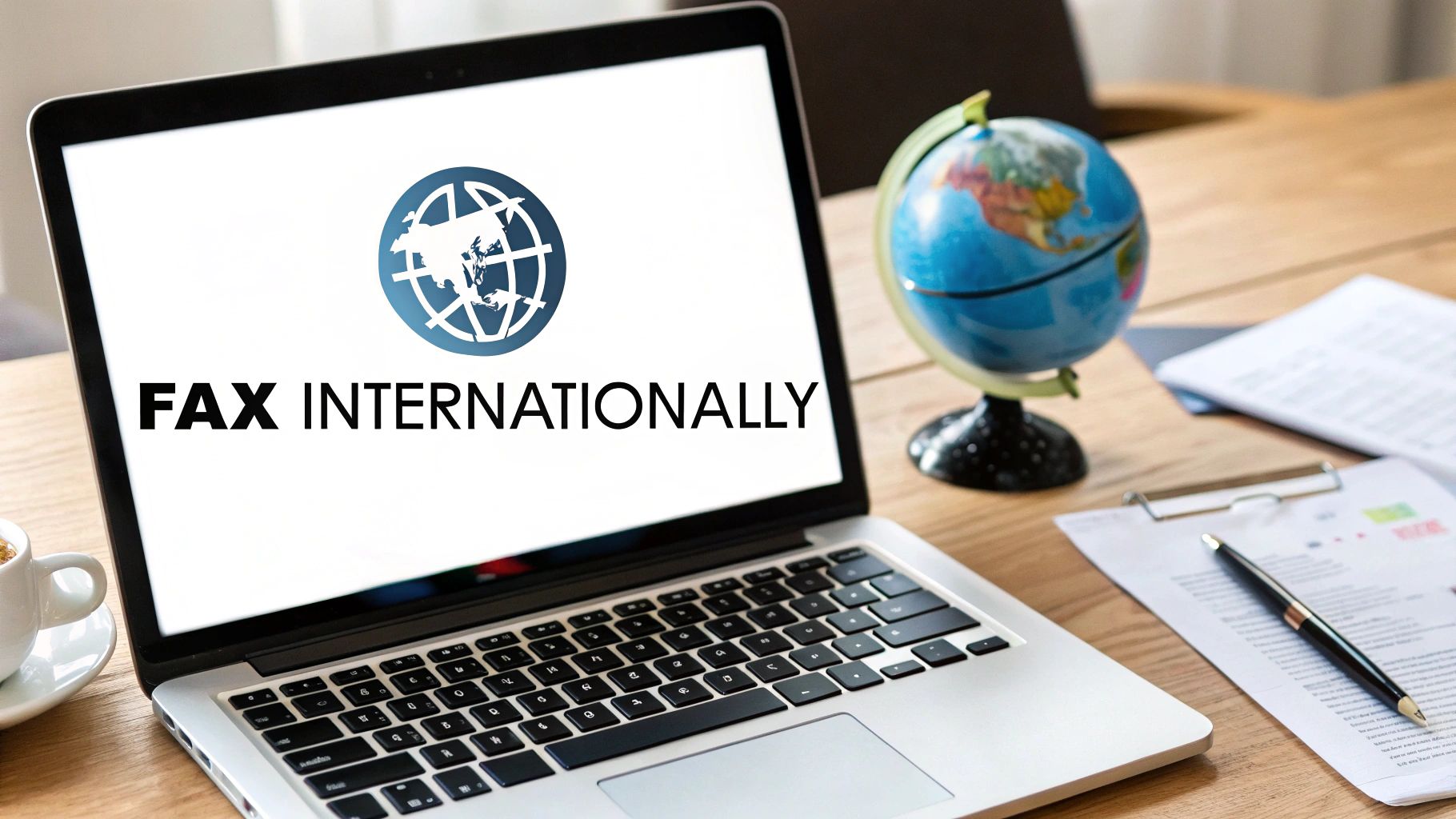Sending a document overseas used to be a real headache, but these days, it’s almost as easy as firing off an email. The simplest method by far is to fax internationally is by using a pay-per-fax online service. These platforms handle all the messy details—like dialing codes and protocols—for you in just a few minutes, completely cutting out the need for a physical fax machine.
Sending International Faxes Without a Machine
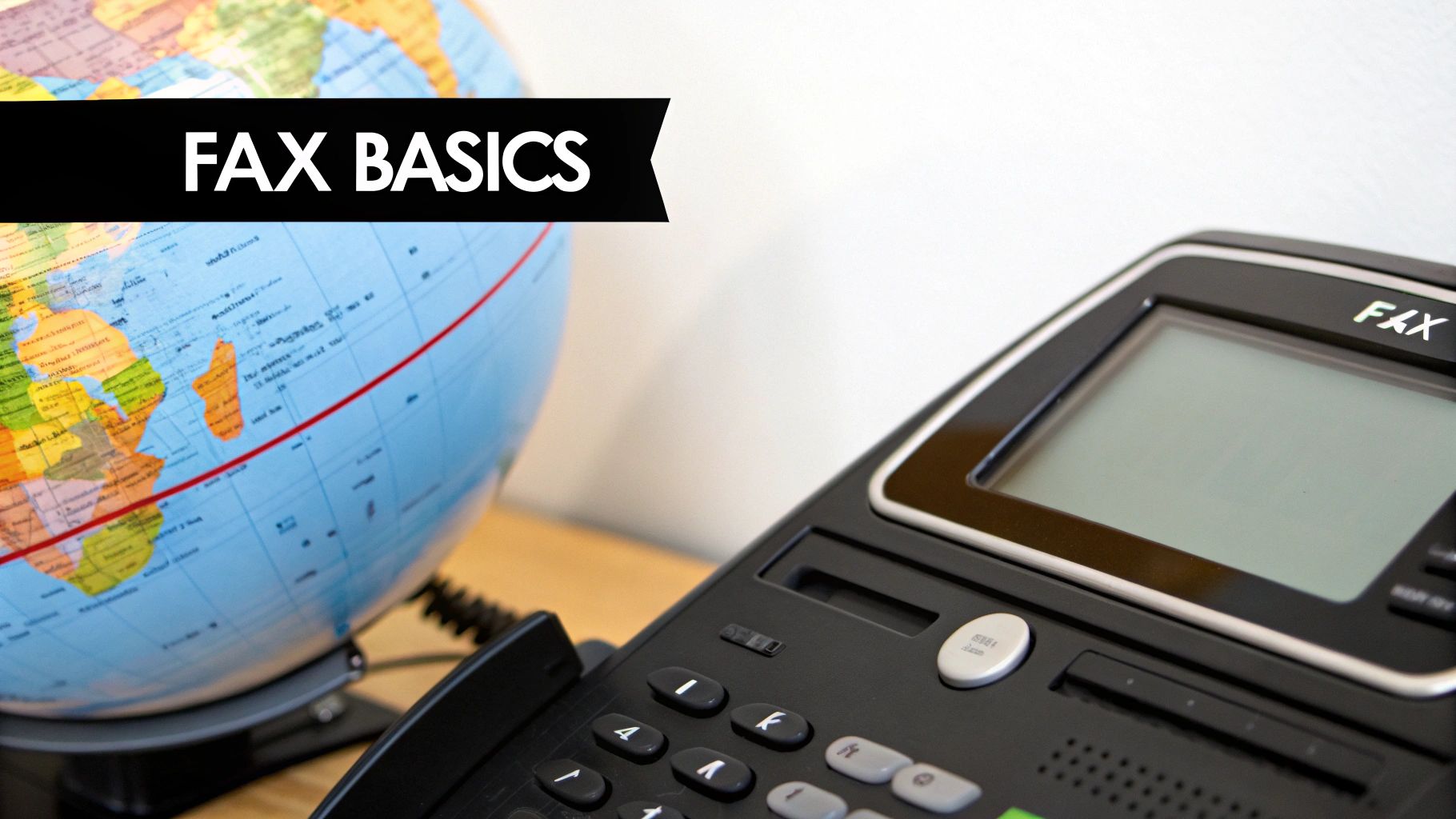
You might be surprised to learn that faxing is still a crucial tool for global communication, especially for official business. It’s not just some old technology clinging to life; it's a trusted one. Many international organizations, from government agencies to medical institutions, still depend on faxes because they provide verifiable proof of delivery—something a standard email just can't promise.
Why Faxing Persists in Global Business
Think about it. Maybe you're applying for a work visa and need to get signed documents to an embassy in Germany. Or you could be a small business owner sending a legally binding contract to a new supplier in Japan. In situations like these, you need a secure way to send your documents that gives you a formal confirmation receipt.
This is exactly where online faxing comes in. It beautifully bridges the gap between old-school requirements and modern convenience. Instead of wrestling with exit codes, country codes, and spotty connections, an online platform does all the heavy lifting for you.
The real value of faxing in an international context is its legal standing. A fax transmission report is a timestamped receipt, offering a level of proof that’s essential for legal, financial, and medical documents.
The Modern, Secure Approach
Before you send that international fax, it's smart to brush up on handling your files securely. This handy guide to secure file storage and transfers is a great starting point for managing your digital documents safely. Online fax services take this a step further by using encryption, which protects your sensitive information as it travels across the globe.
Ultimately, once you know how to use a pay-per-fax service for international sends, you can:
- Ditch the hardware: Send faxes right from your computer or smartphone, no extra equipment needed.
- Guarantee delivery: Get solid proof that your document arrived safely at its destination.
- Stay secure: Transmit sensitive information like contracts or medical records with total confidence.
Choosing the Right Online Fax Service
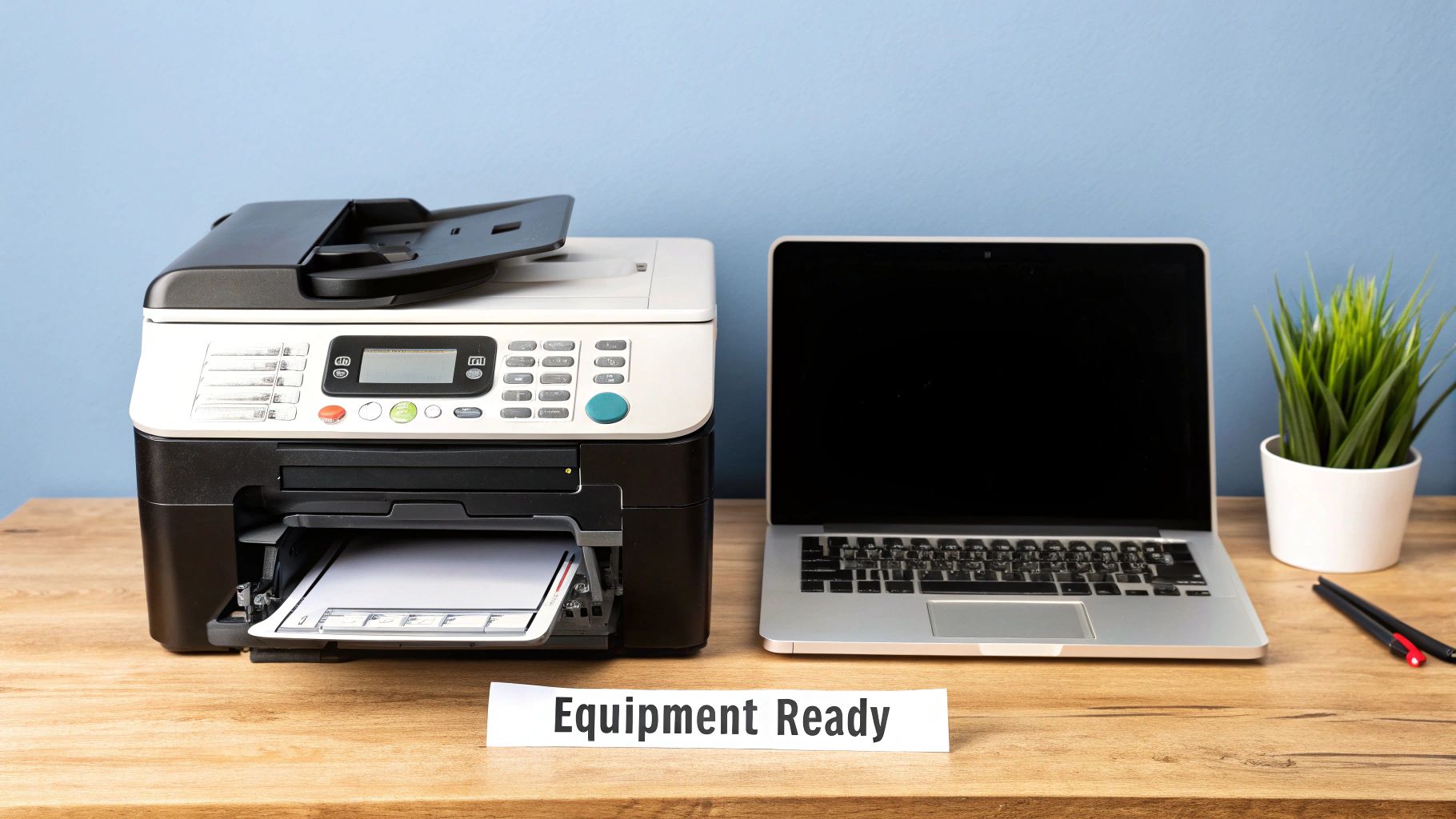
Before you can send that fax across the globe, you’ve got to pick the right platform. This is easily the most important step, because not all services are built the same—especially if you just need to send a one-off document and have no interest in a monthly subscription.
For those one-time needs, a pay-per-fax service is almost always your best bet.
Think about it. You might need to send a single-page invoice to a client in London or a multi-page legal document to an office in Tokyo. A pay-per-fax model is perfect for these tasks because you only pay for what you actually send, making it ideal for things like visa applications or overseas tax forms where you don't need a permanent fax number.
Key Features To Compare
When you’re looking at different options, don’t just stop at the price tag. A good service will give you a clear, transparent breakdown of costs per page for different countries. Sending a fax to Canada, for instance, is often cheaper than sending one to Australia. The best platforms will show you the total cost before you ever hit "send."
Also, look for detailed delivery confirmations. You need more than a simple “sent” notification. A proper transmission report is your proof that the fax arrived successfully, which is non-negotiable for any kind of official business.
A critical feature is the ability to preview your fax before sending. This lets you catch any formatting issues or smudges from a scanned document, ensuring the recipient gets a clean, professional-looking file every time.
Finally, take a quick peek at the supported file types. While most top-tier services handle the usual suspects, it never hurts to double-check. You'll want a service that accepts:
- PDF (.pdf): The gold standard for faxing because its formatting is locked in.
- Word Documents (.doc, .docx): Super convenient and widely accepted.
- Image Files (.jpg, .png): Perfect for sending scanned copies of physical papers.
Choosing a service with a straightforward interface and crystal-clear pricing is what makes the whole process painless. For a deeper look at finding an affordable solution, check out our guide on selecting a cheap online fax service that doesn't skimp on quality. A little prep work here will make sure your international fax gets there without a hitch.
How to Format International Fax Numbers Correctly
I've seen it happen countless times: an urgent international fax fails, and the sender is left scrambling. The most common culprit? A simple, frustrating mistake in the fax number format. Getting this dialing sequence right is absolutely crucial for your document to arrive on the other side of the world.
When you use a pay-per-fax service, things get a lot easier. These platforms are built to handle the tricky parts, but they still rely on you to plug in the number correctly. It’s all about piecing together a few key codes.
A 2019 telecom report found that a shocking 25% of all failed fax transmissions were caused by nothing more than bad dialing protocols. That stat really drives home how important it is to get this part right. You can dive deeper into the technicals in the full 2019 telecommunication consultancy report on DataInsightsMarket.com.
The Anatomy of an International Fax Number
Let's break down the sequence. It's actually a pretty simple formula once you see it in action.
Here are the building blocks of a complete international fax number:
- Exit Code: This is the number you dial to get a line out of your country. If you're faxing from the US or Canada, this is always 011. From most of Europe and other parts of the world, it's usually 00.
- Country Code: This is the unique identifier for the country you're faxing to. For instance, the UK is 44, and Germany is 49.
- Area or City Code: This zeroes in on the specific region within the country. Here's a pro tip: if the local number starts with a '0', you almost always drop that leading zero. This trips up a lot of people.
- Local Fax Number: This is the final, direct number for the recipient’s fax machine.
Let’s walk through a real-world example: sending a fax to an office in London.
Imagine their local number is (020) 7946 0123. From the US, you would string it all together like this:
011 (US Exit Code) + 44 (UK Country Code) + 20 (London Area Code, with the '0' removed) + 79460123 (Local Number)So, the final number you'd type into the fax service is 011442079460123.
This flow chart gives you a bird's-eye view of the entire process, from getting your document ready to confirming it was sent.
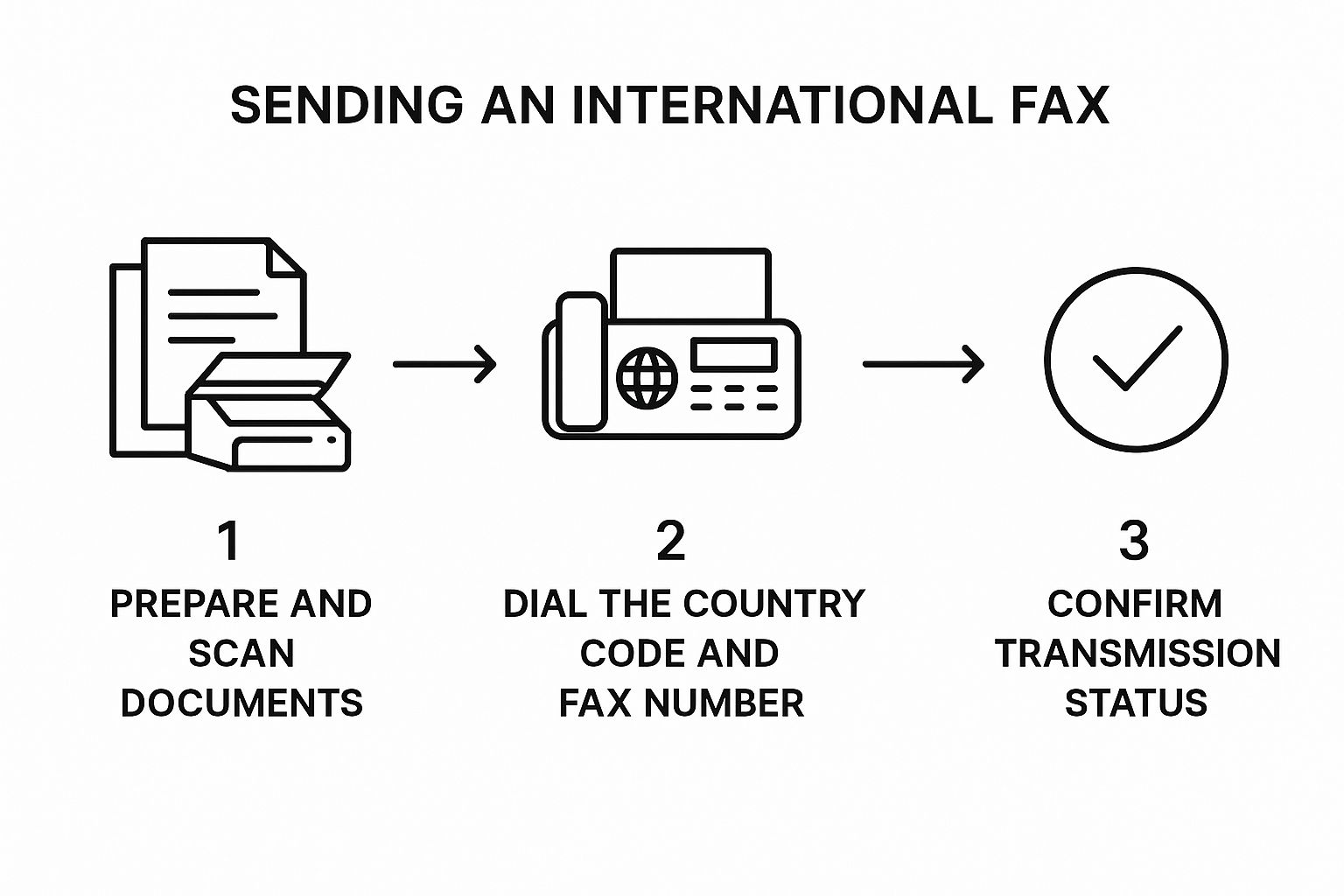
As you can see, nailing the dialing format is the critical link that connects your prepared document to a successful delivery.
Common International Country Codes for Faxing
To make things a bit easier, I've put together a quick-reference table for some of the most common destinations people fax to from the United States.
| Destination Country | Country Code | Example Full Dialing String (from US) |
|---|---|---|
| United Kingdom | 44 | 011 + 44 + [Area Code] + [Number] |
| Australia | 61 | 011 + 61 + [Area Code] + [Number] |
| Germany | 49 | 011 + 49 + [Area Code] + [Number] |
| Mexico | 52 | 011 + 52 + [Area Code] + [Number] |
| Japan | 81 | 011 + 81 + [Area Code] + [Number] |
| France | 33 | 011 + 33 + [Area Code] + [Number] |
| India | 91 | 011 + 91 + [Area Code] + [Number] |
Remember, the key is combining the US exit code (011) with the destination's country code, followed by the local number (and don't forget to drop that leading zero if there is one!).
A Walkthrough of Sending Your First Online Fax
Alright, now that you've got the hang of international dialing formats, let's get down to business. Sending a fax through a modern pay-per-fax service couldn't be more different from the clunky machines of the past. It's now a simple, three-part process: upload your documents, fill in the recipient's details, and hit send.
Let's walk through exactly what to expect.
Your first step is getting your documents into the system. Most platforms I've used let you just drag and drop your files—like PDFs, Word documents, or even JPGs—right into your browser window. This is perfect for those real-world situations, like when you need to combine a scanned passport photo with a digitally signed application form into a single fax.
Next, you'll tackle the recipient's information. This is where you’ll carefully punch in that full international fax number you just learned how to put together. You'll also typically find an option for a free cover sheet. I always tell people to use it. It’s a small touch that adds a layer of professionalism and gives the person on the other end all your key contact info at a glance.
The screenshot below gives you a good idea of what a clean, modern interface looks like. No confusing buttons or clutter, just straightforward fields for the essentials.
See how simple that is? It's all designed to get the job done quickly and without any guesswork.
Finalizing and Sending Your Fax
Before you commit and pay, any reputable service will give you a preview function. Honestly, don't ever skip this step. It’s your last chance to see exactly how your documents will look when they print out on the other side, which can help you catch weird formatting glitches before it’s too late. It also gives you a final, transparent cost based on where you're sending the fax and how many pages it has.
This whole process works thanks to a technology called Fax-over-IP (FoIP), which cleverly sends your fax data over the internet instead of relying on old-school phone lines. The global market for the hardware that supports this is surprisingly big, which just shows how important this tech is for making international faxing both reliable and affordable.
Once you’ve given everything a final look-over and it all seems perfect, you’ll move on to payment. After that, it’s just a matter of hitting the "send" button. From there, you can send an international fax online and watch its progress in real-time, all while waiting for that satisfying delivery confirmation to land in your email inbox.
Confirming Delivery and Understanding Costs
Once you hit "Send," you’re probably wondering, "Did it go through?" Thankfully, any good online fax service won't leave you guessing. You'll get a transmission confirmation report, which is your official, legally recognized proof that the document landed safely on the other side.
This confirmation usually pops up in your email inbox or on your service's dashboard. A successful report will tell you everything you need to know: the exact date and time, the number of pages, and the recipient's fax number. It's the complete audit trail for your records.
What to Do When a Fax Fails
But what if you get a failure notice? Don't sweat it. These reports are actually quite helpful, usually giving you a specific reason like "Busy Signal" or "No Answer."
- Busy Signal: This just means the recipient's fax machine was tied up. The easiest fix is to wait about 15-20 minutes and simply try sending it again.
- No Answer: This could mean their machine was switched off or not connected. It's a good idea to shoot them a quick email or call to make sure their fax line is up and running before you try again.
Think of that confirmation report as more than just a simple notification. For any legal or official paperwork, this timestamped document is your undeniable proof of delivery. It's a big reason why faxing is still the go-to for sensitive information.
How International Fax Costs Work
Sending a fax across borders doesn't have a flat rate; the cost really comes down to the destination country and how many pages you're sending. A one-page fax to Mexico will almost certainly have a different price than a ten-page document going to Japan.
This makes sense when you consider the global fax services market, which was valued at a whopping USD 3.31 billion in 2024. Industries like healthcare and finance rely on this level of secure, verifiable delivery, which keeps the market strong. You can dive deeper into the industry trends on ResearchAndMarkets.com.
The key takeaway is that any trustworthy pay-per-fax service will give you a clear, itemized cost summary before you ever have to enter your payment details. No surprises, just transparency.
Common Questions About International Faxing
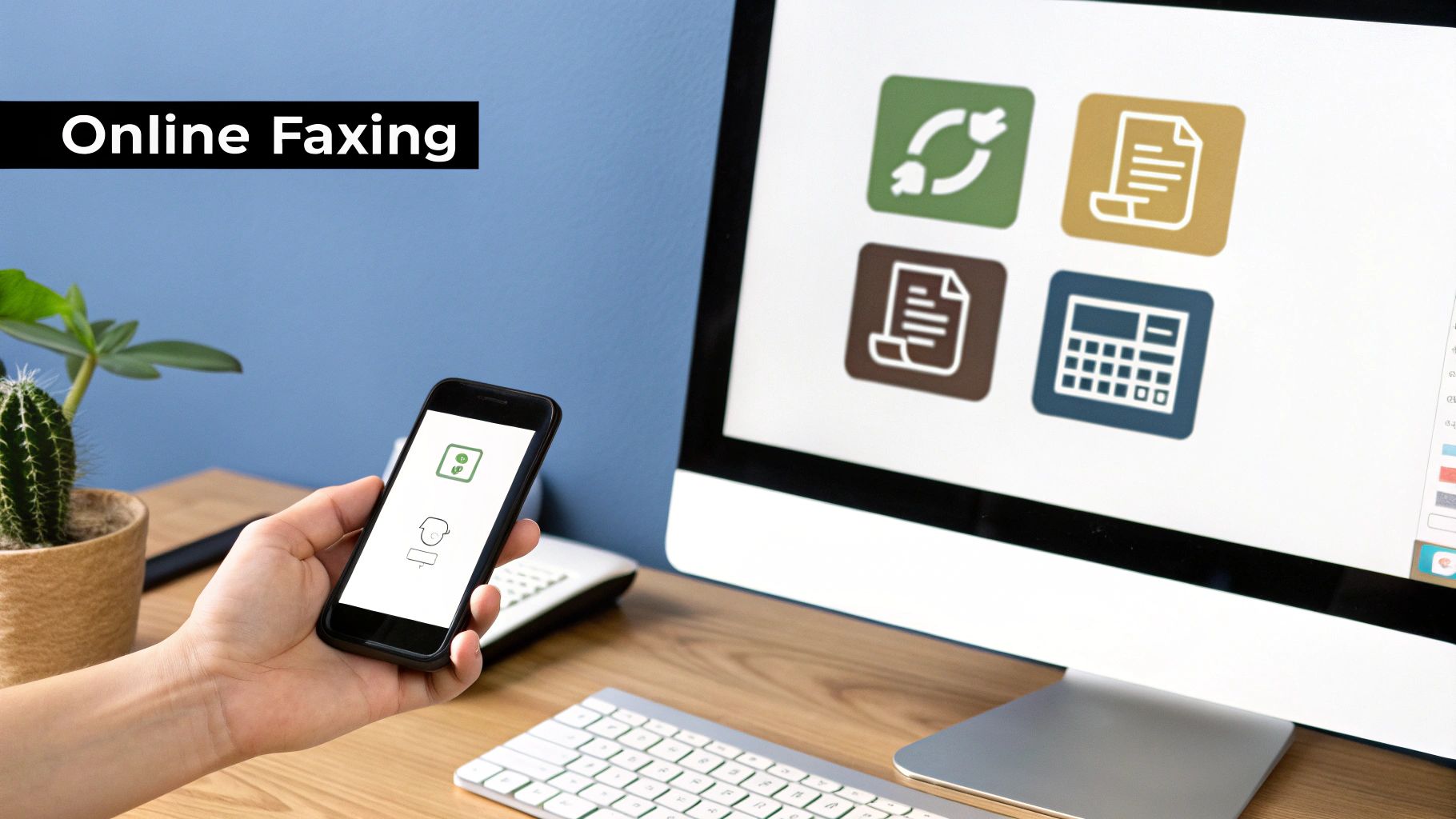
Even when a process seems straightforward, it’s natural to have a few questions pop up. When you’re sending important documents across the globe, you want to be completely confident. Let's tackle some of the most common concerns people have when they start faxing internationally online.
One of the first things people ask me about is security. Is it really safe to send a sensitive contract or private medical records through a web service? The answer is a resounding yes. Reputable services use SSL encryption to scramble your data as it travels, making it just as secure—if not more so—than sending a standard email. Your files are essentially unreadable during transit and are only reassembled at the destination fax machine.
What If My Fax Fails?
"What happens if my fax doesn't go through?" This is another big one, and it's a perfectly valid worry. Thankfully, the solution is built right into the system. If a transmission fails, you'll get an immediate notification, usually with a clear reason like a "busy signal" or an "invalid number."
- For a busy signal: The line is simply occupied. The best move is to wait about 15 minutes and try sending it again.
- For an invalid number: This is your signal to go back and double-check every part of the number—the exit code, the country code, and the local number itself. A single wrong digit is all it takes.
The good news is that most pay-per-fax services, including PayPerFax, operate on a simple principle: you only pay for successful faxes. A failed attempt won't cost you a dime.
The most crucial takeaway is that modern online faxing provides a secure, reliable channel for important documents. Unlike email, you get a definitive confirmation report that serves as legal proof of delivery, which is essential for official correspondence.
Finally, there's the question of file formats. While most platforms are pretty flexible, sticking to standard file types is always your best bet for a smooth experience. PDFs are the gold standard. Why? Because their formatting is locked in, ensuring your document looks exactly as you intended when it prints out on the other end. That said, common formats like DOC/DOCX and JPG are also widely accepted.
Ready to send your international fax with confidence and ease? With PayPerFax, you can send documents to over 130 countries without a subscription or registration. Enjoy transparent, pay-as-you-go pricing, secure SSL encryption, and the convenience of faxing right from your browser. Send your first fax today!

